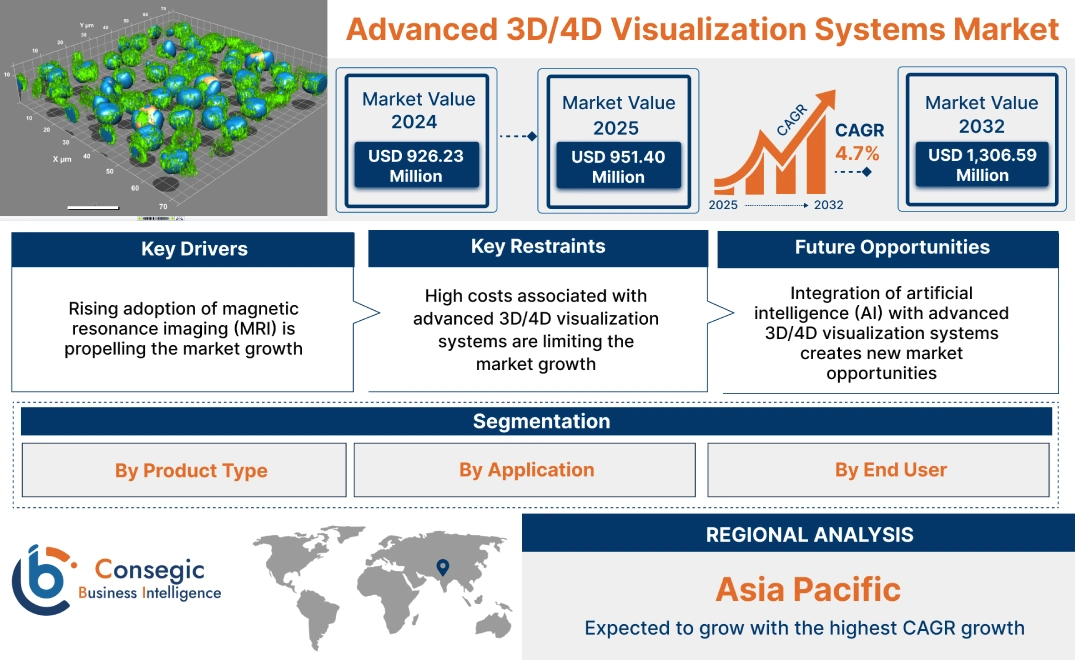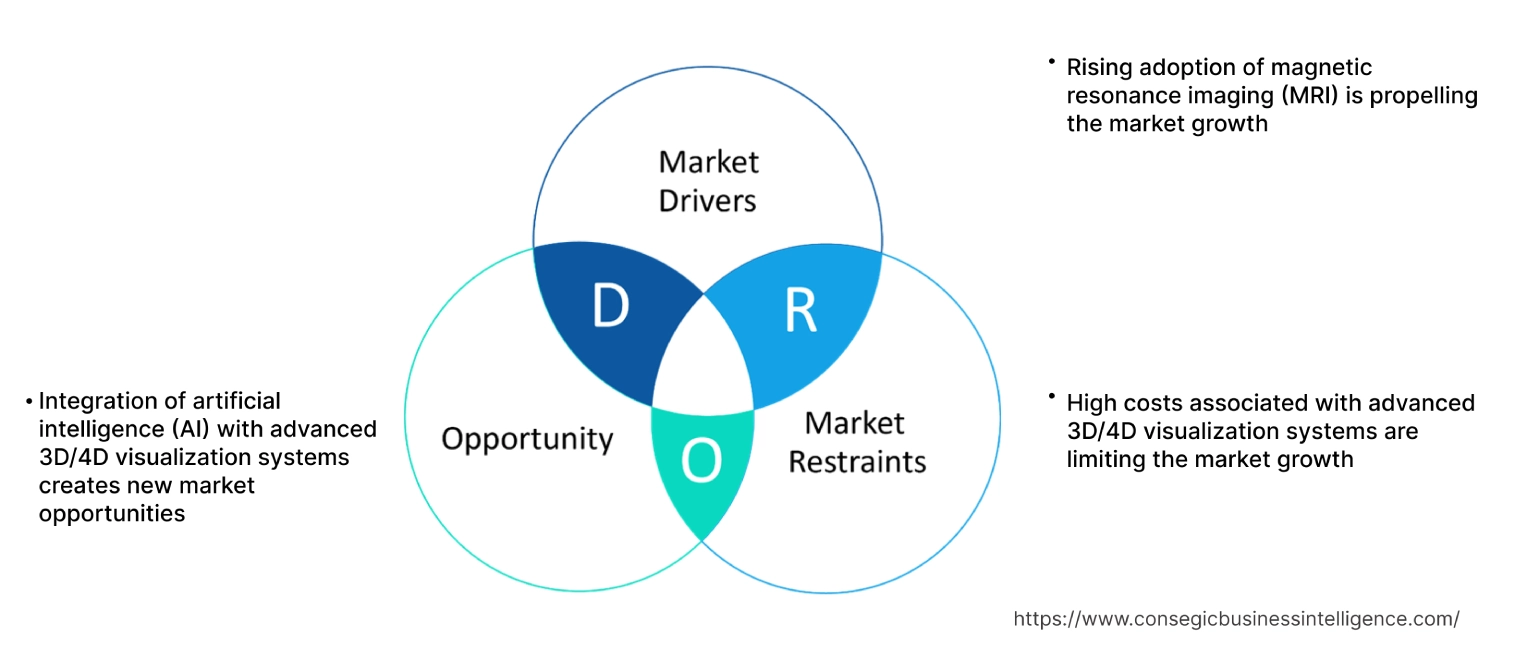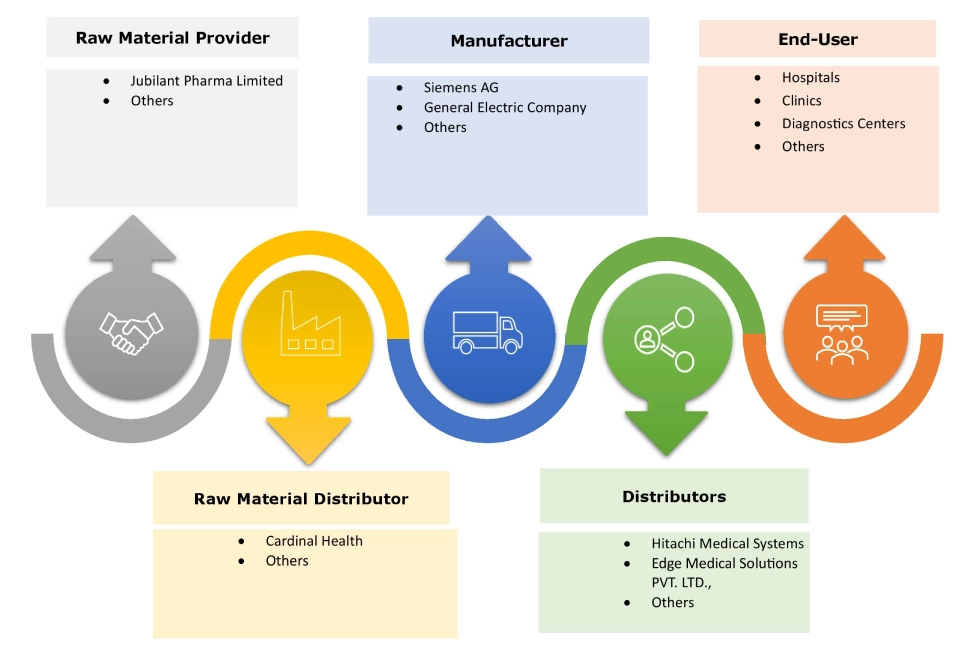- Summary
- Table Of Content
- Methodology
Advanced 3D/4D Visualization Systems Market Size:
Advanced 3D/4D Visualization Systems Market size is estimated to reach over USD 1,306.59 Million by 2032 from a value of USD 926.23 Million in 2024 and is projected to grow by USD 951.40 Million in 2025, growing at a CAGR of 4.7% from 2025 to 2032.
Advanced 3D/4D Visualization Systems Market Scope & Overview:
Advanced 3D/4D visualization systems use computer software to process captured images, providing clinicians with accurate and precise images for better interpretation of results, particularly in fields like healthcare and construction. 3D visualization focuses on creating realistic, spatial models of objects or scenes, enabling users to explore and interact with them in a three-dimensional space. 4D visualization adds a fourth dimension, typically time, to the visualization process, allowing for the analysis of dynamic processes and changes over time. These systems utilize software to manipulate and display data, often from medical imaging or other sources, in a manner that allows users to see and understand complex information in three or four dimensions.
Key Drivers:
Rising adoption of magnetic resonance imaging (MRI) is propelling the market growth
Magnetic resonance imaging (MRI) is a medical imaging technique that uses strong magnetic fields and radio waves to create detailed images of the body's internal structures, without using ionizing radiation. MRI is used to diagnose a wide range of conditions, including tumors, injuries, and diseases of the brain, spinal cord, muscles, bones, and internal organs. 4D flow MRI allows for measurements of blood flow velocity in any vessel within the field of view.
- For instance, in August 2023, Fujifilm launched ECHELON Synergy, a MRI system. The system uses deep learning reconstruction (DLR) technology to enhance the sharpness of images and acquire scans faster.
Thus, the aforementioned factors are boosting the adoption of 3D/4D visualization systems, in turn driving the advanced 3D/4D visualization systems market growth.
Key Restraints:
High costs associated with advanced 3D/4D visualization systems are limiting the market growth
Implementing and maintaining advanced 3D/4D visualization systems requires significant investment in specialized hardware and software, including rendering engines, powerful computers, and 3D modeling/visualization software. Software and hardware require ongoing maintenance, updates, and potential upgrades, which is quite costly.
Moreover, as projects become more complex, the need for even more powerful hardware and software leads to increased costs. Thus, the market trends shows that the aforementioned factors are restraining the advanced 3D/4D visualization systems market demand.
Future Opportunities :
Integration of artificial intelligence (AI) with advanced 3D/4D visualization systems creates new market opportunities
Integrating artificial intelligence (AI) into 3D/4D visualization systems enhances medical imaging analysis that enables deeper insights into complex data by leveraging machine learning and deep learning algorithms to improve accuracy, consistency, and efficiency in diagnosis and treatment. AI algorithms assist in the accurate and efficient interpretation of complex 3D/4D ultrasound data, leading to better care and diagnosis.
- For instance, in February 2025, Prenuvo launched FDA-cleared AI-powered MRI screening systems. The systems perform expanded brain and metabolic health scans, to advance early detection and preventative care.
Thus, the ongoing advancements in technologies and their integration with advanced visualization systems are projected to drive advanced 3D/4D visualization systems market opportunities during the forecast period.
Advanced 3D/4D Visualization Systems Market Segmental Analysis :
By Product Type:
Based on the product type, the market is segmented into magnetic resonance imaging (MRI), computed tomography (CT), positron emission tomography (PET), ultrasound, and others.
Trends in the Product Type:
- Rising demand for PET systems to examine how organs and tissues are functioning is boosting the advanced 3D/4D visualization systems market size.
- Increasing trend in adoption of high-resolution MRI images to help doctors make more accurate diagnoses and treatment plans.
The ultrasound segment accounted for the largest revenue share in the advanced 3D/4D visualization systems market share in 2024.
- 3D/4D ultrasound visualization uses high-frequency sound waves to create a three-dimensional image of internal organs or tissues, offering a more detailed view than traditional 2D ultrasound.
- Moreover, the ultrasound is used to guide interventional procedures, improving accuracy and safety.
- For instance, in February 2025, Butterfly Network Inc. launched next-generation butterfly iQ3. The system is built on technology with the world’s fastest digital data transfer, enhancing frame rates, frequency, and new 3D imaging capabilities.
- Therefore, the wide spread adoption of ultrasound is boosting the advanced 3D/4D visualization systems market growth.
The computed tomography (CT) segment is expected to register the fastest CAGR growth during the forecast period.
- Computed tomography (CT) scans use X-rays and computer technology to create detailed 3D images of the body that enables visualization of internal structures. Specialized software is used to process and visualize the 3D data that allows detailed analysis of the images.
- For instance, in February 2025, Stratasys and Siemens Healthineers co-developed custom 3D-printed phantoms. The new research demonstrates that 3D-printed phantoms are scalable and efficient in developing new CT scan algorithms and improving diagnostic precision.
- Thus, the market trends depicts that the aforementioned factors are expected to boost the advanced 3D/4D visualization systems market trends during the forecast period.
By Application:
Based on the application, the market is segmented into radiology, oncology, cardiology, orthopedics, neurology, vascular, diagnostic, oral, pneumology, and others
Trends in the Application:
- Rising demand for visualization systems in cardiology to assist in diagnosis, surgical planning, and interventional procedures is boosting the advanced 3D/4D visualization systems market size.
- Factors including improved brain scans, lesion identification, and brain structure correlation with function are boosting the usage of visualization systems in neurology.
The radiology segment accounted for the largest revenue share in the advanced 3D/4D visualization systems market share in 2024.
- In radiology, advanced visualization techniques enhance understanding of complex anatomy and pathology. This enables precise surgical planning, diagnosis, and treatment.
- Moreover, visualization allows radiologists and surgeons to view and manipulate 3D/4D models of organs, tissues, and bone structures
- For instance, in June 2024, Rady Children’s Hospital in San Diego offered 3D visualization software. The software allows radiologists to use 3D imaging to better diagnose conditions and view anatomical structures.
- Therefore, the market trends shows that the aforementioned factors are driving the advanced 3D/4D visualization systems market demand.
The oncology segment is expected to register the fastest CAGR growth during the forecast period.
- In oncology, 3D/4D visualization enhances tumor detection, treatment planning, and monitoring by providing detailed, dynamic views of anatomy and disease progression.
- 3D imaging allows for the creation of 3D models of tumors, enabling oncologists to visualize their shape, size, and location with greater accuracy.
- 4D imaging allows oncologists to track changes in tumors over time, evaluate treatment response, and identify potential recurrence.
- Moreover, 4D imaging help visualize the dynamic nature of tumors, which is crucial for understanding their behavior and developing effective treatments.
- Thus, the wide applications of 3D/4D visualization systems in oncology application are expected to boost the advanced 3D/4D visualization systems market trends during the forecast period.
By End User:
Based on the end user, the market is segmented into hospitals and clinics, diagnostic centers, academics, research centers, and others.
Trends in the End User:
- Rising adoption of 3D/4D visualization systems in academics to facilitate better understanding of structures and processes in different medical fields.
- Increasing demand for 3D/4D visualization systems in diagnostics centers for enhanced visualization of anatomical structures that enables better diagnosis and treatment planning.
The hospitals and clinics segment accounted for the largest revenue share of 48.94% in the market in 2024.
- In hospitals and clinics, 3D/4D imaging improves diagnostic accuracy by providing a complete and detailed view of internal structures, leading to more accurate diagnoses and better treatment plans.
- Moreover, the visualization systems have the ability to visualize complex anatomical structures and processes in real-time, which in turn allows for more effective treatment planning and surgical interventions.
- Additionally, the visualization systems enhance diagnostic accuracy, particularly in areas including oncology, where 3D imaging helps in detecting and mapping tumors, and in cardiology, where 4D imaging helps visualize heart valve function and movement.
- Therefore, the rising adoption of 3D/4D visualization systems in hospitals and clinics are driving the advanced 3D/4D visualization systems market expansion.
The research centers segment is expected to register the significant CAGR during the forecast period.
- In research centers, 3D/4D visualization systems allows scientists to explore complex data, offering better understanding and analysis of dynamic processes and structures.
- Moreover, 3D/4D visualization systems are used to analyze large datasets of medical images, identify patterns, and develop new diagnostic and treatment strategies.
- Furthermore, 3D printing technology is used to create models of anatomical implants, structures, or prosthetics, which is used for research and development purposes.
- Thus, the rising usage of 3D/4D visualization systems in research centers is expected to boost the advanced 3D/4D visualization systems market opportunities during the forecast period.
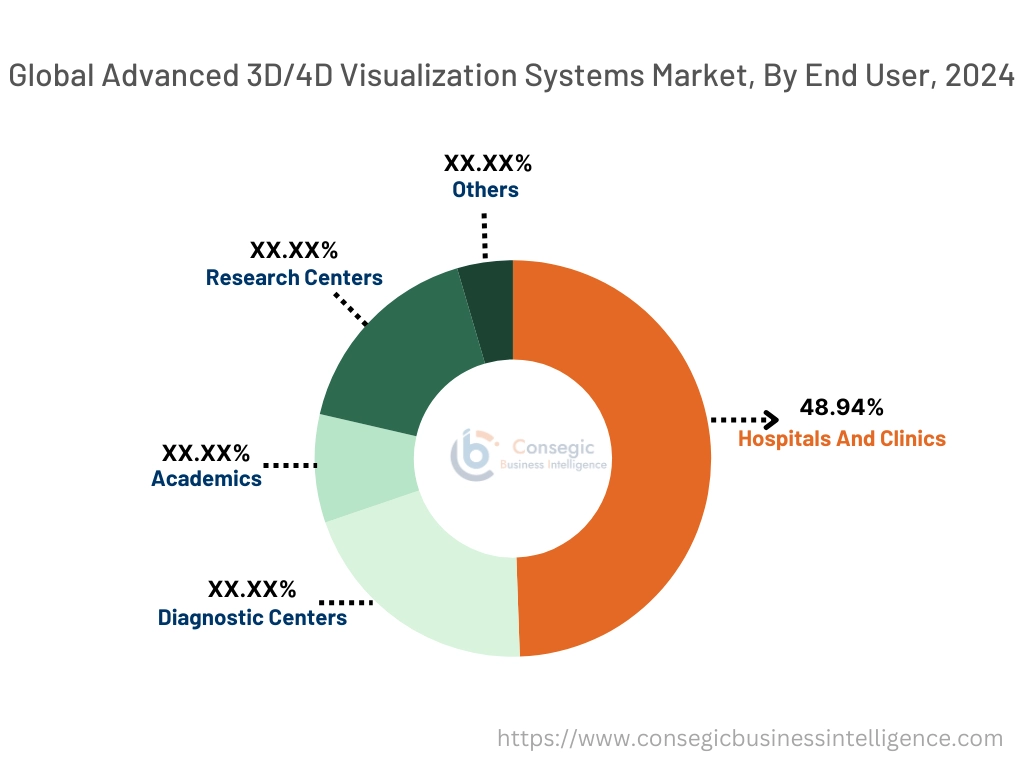
Regional Analysis:
The regions covered are North America, Europe, Asia Pacific, the Middle East and Africa, and Latin America.
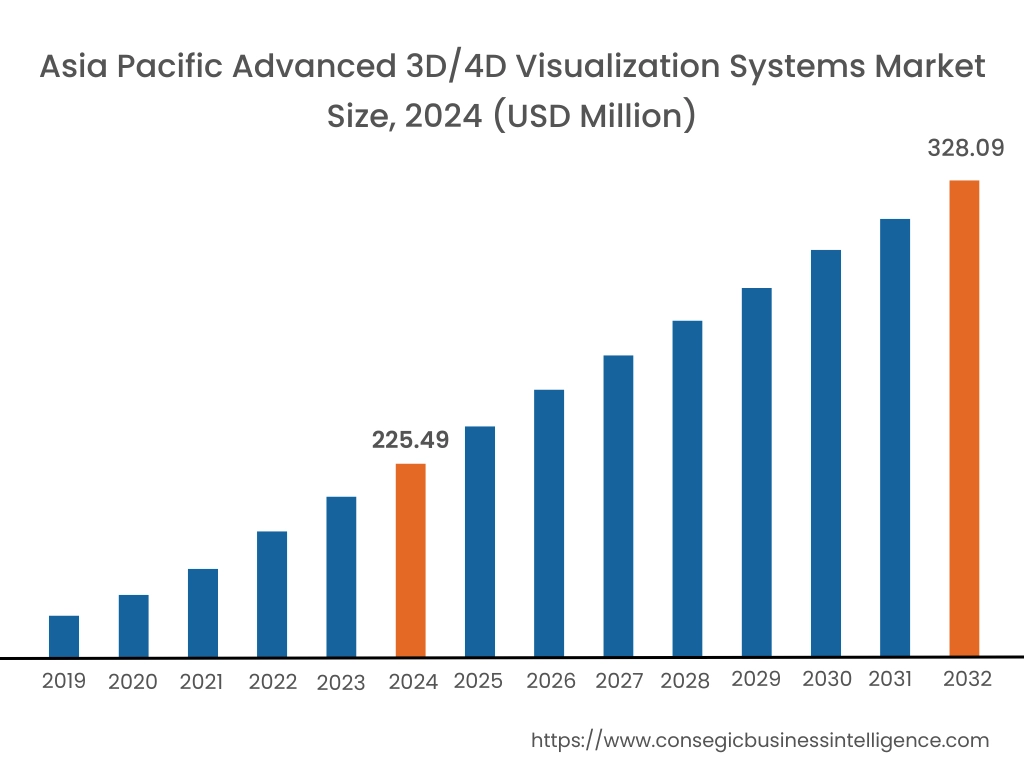
Asia Pacific region was valued at USD 225.49 Million in 2024. Moreover, it is projected to grow by USD 232.23 Million in 2025 and reach over USD 328.09 Million by 2032. Out of this, China accounted for the maximum revenue share of 33.39%. The advanced 3D/4D visualization systems market analysis shows that the market in the region is primarily growing due to expanding healthcare industry due to large population, enhanced visualizations systems, and others. Moreover, the region is also experiencing progress in innovations and advancements in technology, leading to development of advanced visualization systems.
- For instance, in March 2025, India developed its first indigenous MRI machine, at AIIMS, Delhi. The machine aims to provide a more affordable and sustainable alternative. Thus, the rising innovations in the Asia-pacific region are boosting the market growth.
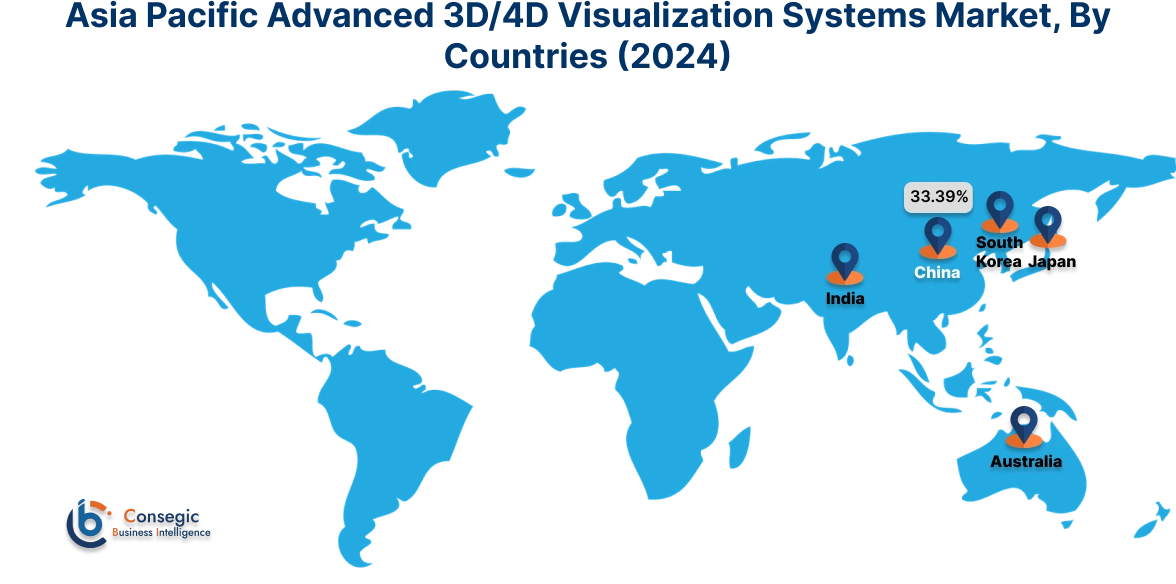
North America is estimated to reach over USD 504.21 Million by 2032 from a value of USD 350.82 Million in 2024 and is projected to grow by USD 360.92 Million in 2025. The market analysis shows that the market in the region is primarily growing due to rising technological advancements in the field of visualization systems. Moreover, the well-established healthcare sector, and the ability to manufacture advanced visualization systems are further driving the market growth.
- For instance, in November 2024, Canon Medical USA launched AI powered MRI system. The platform leverages AI-driven enhancements to deliver high-quality imaging and enhance operational efficiency. Thus, the ongoing technological advancements are boosting the advanced 3D/4D visualization systems market expansion in North America.
Additionally, the advanced 3D/4D visualization systems market analysis depicts that in Europe, the market is primarily driven by increasing cancer patients in the region, leading to wide adoption of advanced visualization systems. As per the regional analysis, the market in the Latin America, Middle East and Africa, is growing due to rising investments in healthcare sector, increasing prevalence of chronic diseases, and others.
Top Key Players and Market Share Insights:
The advanced 3D/4D visualization systems industry is highly competitive with major players providing products to the national and international markets. Key players are adopting several strategies in research and development (R&D), product innovation, and end-user launches to hold a strong position in the global advanced 3D/4D visualization systems market. Key players in the advanced 3D/4D visualization systems industry include -
- Ziosoft (Japan)
- CONMED Corporation (US)
- FUJIFILM Corporation (Japan)
- Carestream Health (US)
- General Electric Company (US)
- Koninklijke Philips N.V. (Netherlands)
- LG Electronics Inc. (South Korea)
- Pro Medicus, Ltd. (Australia)
- Siemens AG (Germany)
- Thermo Fisher Scientific (US)
Recent Industry Developments :
Mergers and Acquisitions:
- In December 2024, Siemens Healthineers acquired Novartis’ Advanced Accelerator Applications Molecular Imaging. The acquired company is a provider of diagnostic radiopharmaceuticals for positron emission tomography (PET) scans.
Advanced 3D/4D Visualization Systems Market Report Insights :
| Report Attributes | Report Details |
| Study Timeline | 2019-2032 |
| Market Size in 2032 | USD 1,306.59 Million |
| CAGR (2025-2032) | 4.7% |
| By Product Type |
|
| By Application |
|
| By End User |
|
| By Region |
|
| Key Players |
|
| North America | U.S. Canada Mexico |
| Europe | U.K. Germany France Spain Italy Russia Benelux Rest of Europe |
| APAC | China South Korea Japan India Australia ASEAN Rest of Asia-Pacific |
| Middle East and Africa | GCC Turkey South Africa Rest of MEA |
| LATAM | Brazil Argentina Chile Rest of LATAM |
| Report Coverage |
|
Key Questions Answered in the Report
What are the major segments covered in the advanced 3D/4D visualization systems market report? +
The segments covered in the report are product type, application, end user, and region.
How big is the advanced 3D/4D visualization systems market? +
Advanced 3D/4D Visualization Systems Market size is estimated to reach over USD 1,306.59 Million by 2032 from a value of USD 926.23 Million in 2024 and is projected to grow by USD 951.40 Million in 2025, growing at a CAGR of 4.7% from 2025 to 2032.
Which region holds the largest revenue share in 2024 in the advanced 3D/4D visualization systems market? +
North America holds the largest revenue share in the advanced 3D/4D visualization systems market in 2024.
Who are the major key players in the advanced 3D/4D visualization systems market? +
The major key players in the market are Ziosoft (Japan), CONMED Corporation (US), FUJIFILM Corporation (Japan), Carestream Health (US), General Electric Company (US), Koninklijke Philips N.V. (Netherlands), LG Electronics Inc. (South Korea), Pro Medicus, Ltd. (Australia), Siemens AG (Germany), Thermo Fisher Scientific (US), and others.
